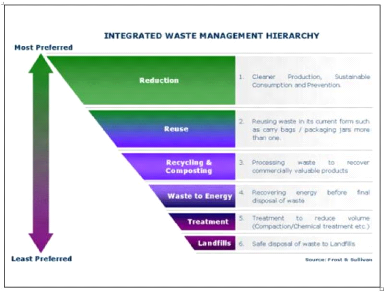2.2.2. Recycling
It involves (1) the separation and collection of waste
materials; (2) the preparation of these materials for reuse, reprocessing, and
remanufacture; and (3) the reuse, reprocessing, and remanufacture of these
materials. Recycling is an important factor in helping to reduce the demand on
resources and the amount of waste require disposal by landfilling (G
Tchobanoglous & 1993). Reusing waste products can be simply made by the
public by returning drink containers to bottling manufacturers and the donation
of used clothes, shoes, furniture, and electrical products to charities and
retailers. Product recycling primarily involves melting glass and metals,
pulping of paper waste so that the end product is useful as a raw material to
manufacturers. Benefits of waste recovery include conserving finite
7
resources, lowering the need for mining or harvesting virgin
material, reducing inert residues from incinerators, and fewer demands on
landfills (Kreith, 1994).
2.2.3. Waste transformation
It involves the physical, chemical, or biological alteration
of wastes. Typically, the physical, chemical, and biological transformations
that can be applied to municipal solid wastes are; (1) to improve the
efficiency of solid waste management operations and system, (2) to recover
reusable and recyclable materials, and (3) to recover conversion products and
energy in the form of heat and combustible biogas. The transformation of waste
materials usually results in the reduced use of landfill capacity
(Tchobanoglous, 1993).
Transformation examples include mechanical clipping,
shredding, and grinding, thermal combustion, and composting organic food and
yard waste (Kreith, 1994). A benefit of thermal incineration is the potential
for energy generation while reducing waste volume up to 90% (Tchobanoglous,
1993).
2.2.4. Landfilling
It is the process by which the solid wastes that cannot be
recycled nor further used; the residual matter remaining after the recovery
facility and after the recovery of conversion products and energy is placed in
a landfill. Although there is a public opposition to landfills, it is necessary
and there is no combination of waste management technique that does not require
landfilling to make them work. Landfilling includes monitoring of the incoming
waste stream, placement and the compaction of waste, and installation of
landfill environmental monitoring and control facilities. Disposing of waste in
a landfill involves burying the waste. A properly-designed and well-managed
landfill can be a hygienic and relatively inexpensive method of disposing of
waste materials. However, poorly-designed or poorly-managed landfills can
create a number of adverse environmental impacts such as wind-blown litter,
attraction of vermin, and generation of liquid leachate (REMA 2010).
Moreover, waste management is the collection, transport,
processing, recycling or disposal, and monitoring of waste materials. The term
usually relates to materials produced by human activity, and is generally
undertaken to reduce their effect on health, the environment or aesthetics.
Waste management is also carried out to recover resources from it. Waste
management can involve solid, liquid, and gaseous substances, with different
methods and
8
fields of expertise for each. Waste management practices
differ for rural, small town, urban or industrial producers (REMA, 2010).
Nevertheless, landfill technique and incinerators are two
methods commonly used for solid waste management (Pandey & Carney, 2005).
Incineration is a disposal method that involves combustion of waste material.
Incineration and other high temperature waste treatment systems are sometimes
described as "thermal treatment". Incinerators convert waste materials into
heat, gas, steam, and ash. Incineration is carried out both on a small scale by
individuals and on a large scale by industry. It is used to dispose of solid,
liquid and gaseous waste. It is recognized as a practical method of disposing
of certain hazardous waste materials (such as biological medical waste).
Incineration is a controversial method of waste disposal, due to issues such as
emission of gaseous pollutants (REMA, 2010).
Fig 2-1: Waste management hierarchy

Source: REMA (2010)
To summarize, solid waste management techniques vary from
country to country depending on physical geography, demographics and level of
economic development. Most industrialized countries have regular solid waste
collection and disposal services, waste disposal sites that are by law required
to have at least some environmental prevention and control techniques
(Nakakawa, 2006).
9
| 


